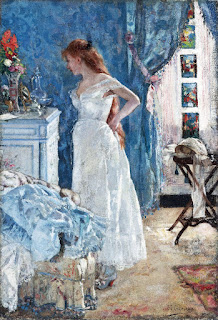Henri Gervex: La Toilette
Zola’s Nana was one of the most widely read naturalist novels from the moment of its appearance in book form. Here, Zola chronicled the rise, adulation and eventual fall and decay of a contemporary sex goddess. The press response to his novel was overwhelming; cartoons continually appeared in the daily Parisian press extolling Zola for having touched upon a societal nerve. The response to Nana was immediate and profound. Edouard Manet created his version of Nana (in 1877) before the extensive text of the novel was published, demonstrating that the literary character, who had been introduced in earlier Zola novels, was already an icon among the public inaugurating and aura of anticipation. By 1880, in a painting that has not been located, Gervex created his first version of Nana. The beautiful young woman is dressing before a large mirror in the company of an elderly maid and a young gentleman. The latter eyes her admiringly, while twirling his moustache in an attitude of ownership. Since Gervex was much taken with the theme of sexuality, and with the significance of Nana as both an emblem and as a figure both used and abused in spite of her beauty, he clearly wanted to create other versions of the same sex goddess. La Toilette follows in this tradition.
In this painting, Gervex focuses on the actions of the young courtesan as she is looking at her reflection in a small mirror on a chest of drawers. Her dress cast aside at the left, her hat thrown on a small table in the rear create an ambiance of disarray; the atmosphere speaks of a sexual encounter -- a moment made more intense by the pensive look of the young woman. What connects the scene to Zola’s novel, and to Nana in particular, is the fact that this interior suggests a fashionable decor where plush draperies and rich carpeting reveal the type of environment in which Nana must have lived. At the right, a small series of stained glass panels, hanging in front of a large French window from which the light that illuminates the scene enters the room, further heightens the richness of the setting and reveals the current taste for stained glass in interiors. The use of these details suggests contemporaneity. The work is painted with a very broadly brushed surface and with an understanding of the color tonalities of Impressionism. In this canvas, Gervex demonstrates that he has understood the innovations of the Impressionist painters. The work is also treated with the same lively brushed style and tonality as Gervex's Rolla, which would date it in the late 1870s or very early 1880s. [Schiller & Bodo]

No comments:
Post a Comment